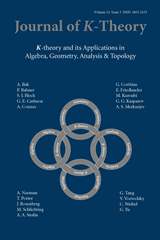Article contents
Geometry of Reidemeister classes and twisted Burnside theorem
Published online by Cambridge University Press: 04 March 2008
Abstract
The purpose of the present mostly expository paper (based mainly on [17, 18, 40, 16, 11]) is to present the current state of the following conjecture of A. Fel'shtyn and R. Hill [13], which is a generalization of the classical Burnside theorem.
Let G be a countable discrete group, φ one of its automorphisms, R(φ) the number of φ-conjugacy (or twisted conjugacy) classes, and S(φ) = #Fix the number of φ-invariant equivalence classes of irreducible unitary representations. If one of R(φ) and S(φ) is finite, then it is equal to the other.
the number of φ-invariant equivalence classes of irreducible unitary representations. If one of R(φ) and S(φ) is finite, then it is equal to the other.
This conjecture plays a important role in the theory of twisted conjugacy classes (see [26], [10]) and has very important consequences in Dynamics, while its proof needs rather sophisticated results from Functional and Noncommutative Harmonic Analysis.
First we prove this conjecture for finitely generated groups of type I and discuss its applications.
After that we discuss an important example of an automorphism of a type II1 group which disproves the original formulation of the conjecture.
Then we prove a version of the conjecture for a wide class of groups, including almost polycyclic groups (in particular, finitely generated groups of polynomial growth). In this formulation the role of an appropriate dual object plays the finite-dimensional part of the unitary dual. Some counter-examples are discussed.
Then we begin a discussion of the general case (which also needs new definition of the dual object) and prove the weak twisted Burnside theorem for general countable discrete groups. For this purpose we prove a noncommutative version of Riesz-Markov-Kakutani representation theorem.
Finally we explain why the Reidemeister numbers are always infinite for Baumslag-Solitar groups.
Keywords
Information
- Type
- Research Article
- Information
- Journal of K-Theory , Volume 2 , Special Issue 3: In Memory of Yurii Petrovich Solovyev October 8, 1944–September 11, 2003 , December 2008 , pp. 463 - 506
- Copyright
- Copyright © ISOPP 2008
References
- 9
- Cited by

